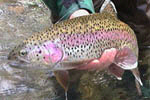|
The secret to Robís quill-body flies is,
you guessed it, the quill-body. He uses his own McLeanís Quill Body
material, which is described in an excellent article by Stephen Hays
called "Slickwater Quill-Body Flies" in the March, 2000 issue of Fly
Fisherman magazine. And, of course, feel free to contact Rob at the
e-mail address above.
Bob uses porcupine guard hairs for the
quills that were used in the two quill-body flies shown above. Donít
confuse porcupine guard hairs with porcupine quills, however. Rob
points out that the guard hairs are somewhat hollow, as evidenced by
the fact that they can be flattened with a thumbnail. He feels that
this results in more buoyancy than other quill
types.
As you can see in the beautiful samples
above, the material shines and shows segmentation, very much like a
real insect body. Dyeing is not easy, but Rob has developed a system
that gets the job done without making the quills
brittle.
Rob says the guard hairs rarely break
while wrapping, but they do suffer from cuts and bruises from trout
teeth and forceps. He suggests applying a drop of head cement at the
tie-in and tie-off points. Ribbing with monofilament thread reduces
the sheen of the body, writes Hays, but my thought is that it likely
reinforces the quill.
Hays mentions two other tips suggested
by Rob. First, use a few "soft" wraps of thread when tying off the
material, with more tension for the final wraps. This will reduce
the chance of cutting through the material. The second tip is to
taper the body, if desired, with a thread underbody, before wrapping
the quill body.
--Peter Frailey
|



